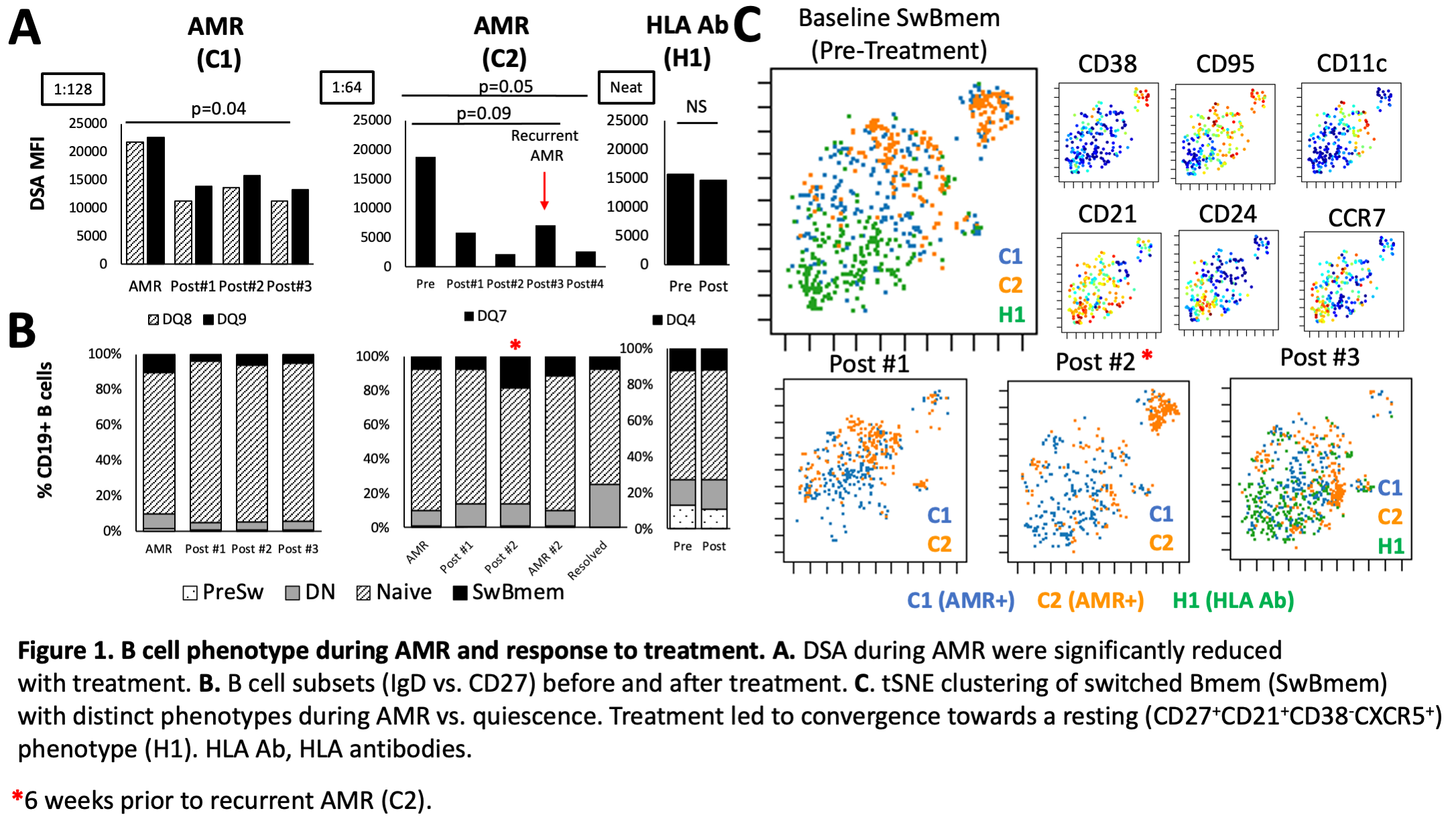Longitudinal Characterization of Memory B Cells During Antibody Mediated Rejection Treated with Plasmapheresis, Bortezomib, and Belatacept in Heart Transplant Recipients
1Columbia University Medical Center, New York, NY, 2University of Pittsburgh Medical Center, Pittsburgh, PA, 3University of Chicago, Chicago, IL
Meeting: 2022 American Transplant Congress
Abstract number: 241
Keywords: Alloantibodies, B cells, Co-stimulation, Immunosuppression
Topic: Clinical Science » Heart » 63 - Heart and VADs: All Topics
Session Information
Session Name: Heart and VADs: All Topics II
Session Type: Rapid Fire Oral Abstract
Date: Monday, June 6, 2022
Session Time: 3:30pm-5:00pm
 Presentation Time: 4:40pm-4:50pm
Presentation Time: 4:40pm-4:50pm
Location: Hynes Room 210
*Purpose: Donor specific antibodies (DSA) and antibody mediated rejection (AMR) continue to limit allograft longevity after heart transplant. Effective treatments are limited and often complicated by rebound.
*Methods: We characterized the circulating memory B cell (Bmem) phenotype (CyTOF), DSA (titer, IgG subclass) and biopsy findings during AMR in two heart transplant recipients and prospectively followed the response to treatment with corticosteroids (CS), plasmapheresis (PP), bortezomib (BTZ), and belatacept (BEL). A recipient with HLA antibodies (H1), where BEL was added to standard of care immunosuppression (SOC), was used for comparison.
*Results: Case 1 (C1) presented with acute on chronic AMR and had a sustained response to treatment (mild persistent chronic AMR). Case 2 (C2) developed acute AMR during post-rituximab peripheral B cell reconstitution, initially responded, then rebounded. Retreatment led to a significant reduction in DSA (p=0.05) and complete biopsy resolution (grade 0). Monthly BEL was continued in both cases. We analyzed B cell subsets (Fig 1B) noting a sustained reduction in switched CD27+IgD– B cells (SwBmem) in C1 (10.5 to 5.0%), a rapid increase prior to recurrent AMR in C2 (7.3 to 18.2%), and no change in H1 (12.3 to 11.9%). SwBmem during AMR clustered distinctly from quiescence (H1) with higher frequencies of CD27++CD38++ antibody secreting cells (ASCs) and activated Bmem (CD27+CD38-/loCD21-/lo CD11chiCD95hi). Transient robust ASC expansion occurred 6 weeks prior to recurrent AMR (C2) which diminished before retreatment with CS/PP/BTZ. IgD–CD27-/lo B cells before recurrence were enriched for a CD38+CD95+Ki67+ phenotype. At the time of histological recurrence while on BEL/SOC, Ki67+ B cells, ASCs, and activated Bmem were suppressed.
*Conclusions: Our preliminary characterization of circulating Bmem during AMR suggests features common to those described in kidney transplantation including increased frequencies of ASCs and activated Bmem. Treatment combining CS/PP/BTZ with BEL/SOC reduced DSA, ASCs, and activated Bmem. Rapid but transient B cell proliferation with distinct characteristics preceded recurrent AMR. Additional cases are being prospectively studied and will be compared to patients undergoing desensitization with a similar protocol.
To cite this abstract in AMA style:
Alkhunaizi F, Ellison M, Berrich V, Siegelin M, Szabolcs M, Sayer GF, Uriel N, Restaino S, Chong A, Zeevi A, Habal M. Longitudinal Characterization of Memory B Cells During Antibody Mediated Rejection Treated with Plasmapheresis, Bortezomib, and Belatacept in Heart Transplant Recipients [abstract]. Am J Transplant. 2022; 22 (suppl 3). https://atcmeetingabstracts.com/abstract/longitudinal-characterization-of-memory-b-cells-during-antibody-mediated-rejection-treated-with-plasmapheresis-bortezomib-and-belatacept-in-heart-transplant-recipients/. Accessed December 15, 2025.« Back to 2022 American Transplant Congress

